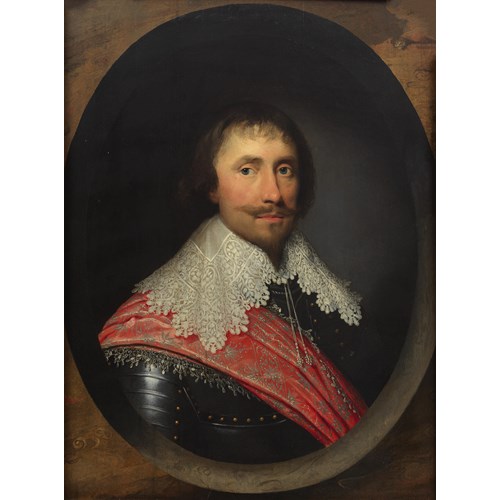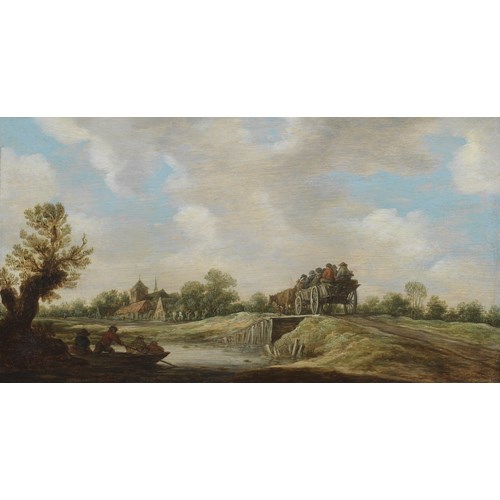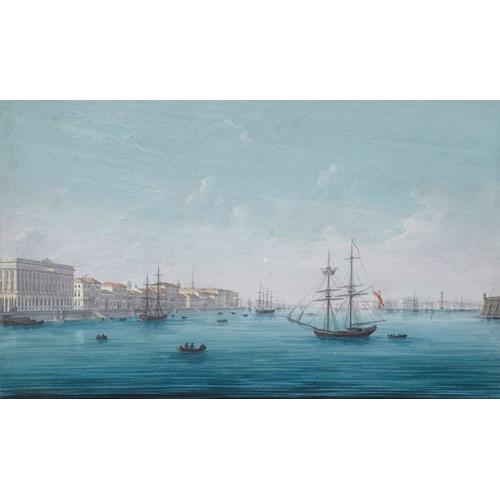Jan de Bray
The Adoration of the Magi
Date 1658
Epoque 1600-1750, 17th century
Origine The Netherlands
Medium Oil on oak panel
Dimension 71 x 55 cm (28 x 21⁵/₈ inches)
Kneeling closely behind are the two remaining biblical Magi. One wears a fur mantle, and in his hand clutches a decorative silver incense burner, presumably containing either the frankincense or myrrh. The other, his gift concealed, wears a red cloak and gazes intently at the infant Jesus. In the background, several armed soldiers and a plumed horse, representative of the Magi’s entourage, watch the activity unfolding inside the stable. The simple, rustic interior depicted is in keeping with the traditional stable believed to have housed the Adoration of the Magi; for example, the stack of logs on the left foreground and the wooden beamed ceiling. In the right foreground there is an open barrel with material slung over the side, and the stick that lies below suggests that this equipment is used for washing. Standing behind the Virgin on the right is the bearded figure of Joseph. With his left arm he leans on wooden machinery, which possibly refers to his métier as a carpenter.
As the recent exhibition catalogue, Painting Family: The de Brays (see lit.) discusses, ‘Jan de Bray was one of a large family of painters living and working in Haarlem; his father, Salomon, was a successful artist, as were two of Jan’s brothers, Dirck and Joseph. The family worked together very closely, studying each other’s paintings, sharing advice, and maintaining an archive of the workshop’s production. A feature of this studio practice was that Jan and the other de Brays regularly made drawn copies of the paintings produced in the family workshop, drawings that served not only as archival records, but also as prospecti for future clients who might want to commission similar paintings.’
Painted in 1658, The Adoration of the Magi and the drawing made after it is an example of this practice in the family workshop. De Bray returned to the subject of the Adoration once again in 1674. Most likely using the preparatory drawing from the present work, he completed the larger canvas, which is now in the Historisches Museum, Bamberg.¹
The Bamberg picture depicts the Adoration from a somewhat closer viewpoint with almost exactly the same central figure grouping as the present work, and displays a more expertly designed and neater composition. Though the two works are virtually identical, the face of the Virgin is notably different. In the present work she appears youthful, almost girlish, with softened curls and subtly coloured cheeks, whereas in the Bamberg picture the Virgin is depicted as older and the rendering of her facial features and gaze towards the infant Jesus references the work of Leonardo da Vinci (1452-1519). Furthermore, in the Bamberg version she wears a yellow scarf wrapped around her head and neck, whereas in the present work it hangs loosely around her neck.
Paintings by Salomon de Bray (1597-1664) and his son Jan have often been confused in the literature. The confusion originates in descriptions in old sale catalogues: for example the present picture appears to be the one sold as Salomon de Bray in 1773, and can be identified with greater certainty as the one sold as by ‘Jacob de Bray’, dated 1658, in the van Bergen van der Gryp sale in 1784. Von Moltke therefore listed what was probably the same picture in his catalogue raisonnés of both artists. To further muddle the situation, the present picture was sold at Christie’s in 1946 with an attribution to Gerbrand van den Eeckhout. A photograph at the Rijksbureau voor Kunsthistoriche Documentatie in The Hague records subsequent attributions: to Jan de Bray made by Horst Gerson; and to Salomon de Bray by Albert Blankert. The question was resolved with finality when the connection between the painting and Jan de Bray’s signed drawing was published by Ariane van Suchtelen in 1997 (private collection).
De Bray worked in Haarlem for virtually the whole of his career, except for the period 1686-1688, when he lived in Amsterdam where he helped to design a freshwater reservoir. As in Utrecht, most of the Haarlem painters remained Catholic unlike their Protestant counterparts in Amsterdam. After training with his father, de Bray began working as a portrait painter in Haarlem in 1650, an activity he continued for the next forty years. Between 1667 and 1684 he served on the committee for the Haarlem Guild of St. Luke, whose leading members he portrayed in a picture dated 1675 - Leading Members of the Haarlem Guild of St Luke, which includes a self-portrait (Jan is seen standing and drawing on the left). He married three times, in 1668, 1670 and 1672. His first two wives died a year after their marriage, his third two years afterwards, and in each case the death was followed by disputes over the inheritance. De Bray’s bankruptcy of 1689 may have been a result of one of the lawsuits. He was sixty-two at the time, and from then onwards he seems to have lost his artistic drive, crushed by the financial blow and the consequent loss of social position.
As a key figure in Dutch Classicalism of the seventeenth century, de Bray, like his contemporaries, drew inspiration from the same ancient writers and sources as the Italian artists of the fifteenth century. Working in the classical tradition, these artists emphasised harmony, proportion and balance in their compositions in order to present an idealised beauty.
¹ De Bray also completed a similar scene depicting the Adoration of the Shepherds in 1665, now held in the Mauritshuis Royal Picture Gallery, The Hague.
Date: 1658
Epoque: 1600-1750, 17th century
Origine: The Netherlands
Medium: Oil on oak panel
Signature: Indistinctly signed and possibly dated (lower right, to the right of the kneeling king’s crown).
Dimension: 71 x 55 cm (28 x 21⁵/₈ inches)
Provenance: Anonymous sale, Amsterdam, de Winter & Yver, 8 September, 1773, lot 34 (apparently as Salomon de Bray), to J. van der Hoogt (according to Hofstede de Groot, cited by von Moltke under Literature);
possibly anonymous sale, Amsterdam, 1 October, 1778, Ploos v. A. & Yver, lot 35 (as Salomon de Bray), to Delfos for 25 Guilders;
Johannes van Bergen van der Gryp, Malucca and Leiden, His deceased sale, Soeterwoude, A. Delfos, 25 June 1784, lot 12 (as Jacob de Bray);
anonymous sale, London, Christie’s, 29 November, 1946, lot 137 (as G. van den Eeckhout), to Agnew’s;
with Thomas Agnew & Sons Ltd., London, 1949, from whom acquired by John Vaughan-Morgan, later Lord Reigate;
thence by family descent;
Sold, London, Sotheby’s July 7, 2005 lot 14;
with Otto Naumann.
Literature: Probably J.W. von Moltke, ‘Salomon de Bray’ in Marburger Jahrbuch für Kunstwissenschaft,vols. 11-12, 1938-9, p. 382, no. 34 (recording the 1773 sale; as Salomon de Bray);
J.W. von Moltke, ‘Jan de Bray’, in Marburger Jahrbuch für Kunstwissenschaft, vols. 11-12. 1938-9, p. 466, no. 14
(recording the van Bergen van der Gryp sale; as ‘Jan de Bray’);
A. van Suchtelen, ‘De aanbidding der herders door J. de Bray’, in Mauritshuis in Focus, vol. 10, 1997, pp. 14-16, also footnote 4;
J. Giltaij, in Dutch Classicism in Seventeenth Century Painting, exhibition catalogue, Rotterdam 1999, p. 303, under cat. no. 59, reproduced fig. 9b (as whereabouts unknown);
P. Lammerstse, Painting Family: The de Brays, exhibition catalogue, Haarlem (Frans Hals Meseum) and London (Dulwich Picture Gallery) 2008, p. 104, illus. no. 37b;
J. Giltaij, Jan de Braij (1626/1627-1697), Schilder en architect, Zwolle 2017, pp. 32-33, 81, cat. no. 9, reproduced p. 80.
Plus d'œuvres d'art de la Galerie









